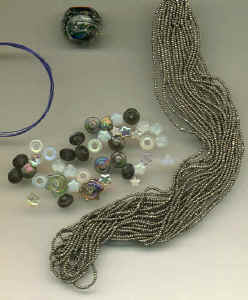 |
This is the start of a
necklace. The large lampworked bead is by Andrea Guarino who simply calls it
"wire bead". To me, however, it looks like some planet in a galaxy far,
far away. That, of course, would be much too long for a name, so it will be called
"Stargate", after the TV show on channel 31. It will be strung vertically,
like a pendant with multiple strands of pewter charlottes and since I cannot imagine even
a galaxy far, far away to be devoid of other heavenly bodies, it will also incorporate
stars and asteroids and other dark planets with rings like Saturn.
|
